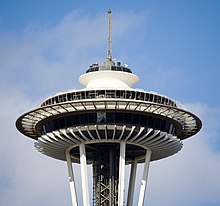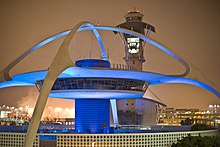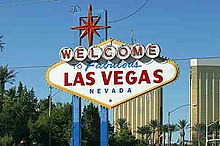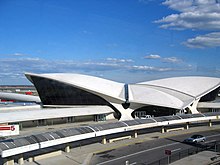Usuário(a):Dalton Holland Baptista/WBG


Googie (também conhecido como populuxe ou Doo-Wop) é um ramo da arquitetura moderna e uma subdivisão da arquitetura futurística. Influenciado pela cultura automobilística e as eras espacial e atômica,[1] surgiu no Sul da Califórnia durante o final da década de 1940, continuando a prevalecer até meados dadécada de 1960. Os tipos de construções mais projetadas em estilo Googie eram motéis, cafeterias e pistas de boliche.[2][3][4] O termo Googie provém de um café em West Hollywood, já demolido.[5]
Entre as características do Googie estão tetos elevados e curvilíneos, figuras geométricas e o uso arrojado de vidro, aço eneon. Era também caracterizado por elementos da era espacial ou que simbolizassem movimento tais como bumeranguess, discos voadores, átomos e parábolas, alem de desenhos em forma livre como paralelogramas arrdondados, ou o formato da paleta de um pintor. Estas convenções estilística representaram a fascinação do sociedade estadunidense pelos temas espaciais e pela propaganda que enfatizava linhas futuristas. Assim como ocorreu com o estilo Art Deco da década de 1930, o Googie tornou-se cada vez mais desvalorizado com o passar do tempo, e muitas construções feitas neste estilo foram demolidas. Alguns exemplos foram preservados, contudo, como o primeiro McDonald's, que desde 1983 faz parte do National Register of Historic Places dos Estados Unidos.
Origens[editar | editar código-fonte]
A origem do nome Googie data de 1949, quando o arquiteto John Lautner projetou o café Googie's em West Hollywood, que apresentava algumas características arquitetônicas precursoras deste estilo.[6] "Googie" era o apelido de Lillian K. Burton, esposa de seu proprietário original, Mortimer C. Burton.[7][8] O Googie's ficava na esquina da Sunset Boulevard e Crescent Heights em Los Angeles mas foi demolido em 1989.[9] O nome Googie passou a designar este estilo quando o editor da "House and Home", Douglas Haskell e o fotógrafo Julius Shulman dirigiam por Los Angeles. Haskell insistiu em parar ao ver o café e proclamou: "Esta é a arquitetura Googie."[6] ele popularizou o nome depois em um artigo de seus artigos, publicado na revista em 1952.[10][11]
História[editar | editar código-fonte]

Googie's beginnings are with the Streamline Moderne architecture of the 1930s.[13] Alan Hess, one of the most knowledgeable writers on the subject, writes in Googie: Ultra Modern Road Side Architecture that mobility in Los Angeles during the 1930s was characterized by the initial influx of the automobile and the service industry that evolved to cater to it. With car ownership increasing, cities no longer had to be centered on a central downtown but could spread out to the suburbs, where business hubs could be interspersed with residential areas. The suburbs offered less congestion by offering the same businesses, but accessible by car. Instead of one main store downtown, businesses now had multiple stores in suburban areas. This new trend required owners and architects to develop a visual imagery so customers would recognize it from the road. This modern consumer architecture was based on communication.[14]
The new smaller suburban drive-in restaurants were essentially architectural signboards advertising the business to vehicles on the road. This was achieved by using bold style choices, including large pylons with elevated signs, bold neon letters and circular pavilions.[15] Hess writes that because of the increase in mass production and travel during the 1930s, Streamline Moderne became popular because of the high energy silhouettes its sleek designs created. These buildings featured rounded edges, large pylons and neon lights, all symbolizing, according to Hess, "invisible forces of speed and energy", that reflect the influx of mobility that cars, locomotives and zeppelins brought.[16] Streamline Moderne, much like Googie, was styled to look futuristic to signal the beginning of a new era – that of the automobile and other technologies. Drive-in services such as diners, movie theaters and gas stations built with the same principles developed to serve the new American city.[16] Drive-ins had advanced car-oriented architectural design, as they were built with an expressive utilitarian style, circular and surrounded by a parking lot, allowing all customers equal access from their cars.[17] These developments in consumer oriented design set the stage for Googie during the 1950s, since during the 1940s World War II and rationing caused a pause of development because of the imposed frugality on the American public.
The prosperous 1950s, however, celebrated its affluence with optimistic designs. The development of nuclear power and the reality of spaceflight captivated the public’s imagination of the future.[18] Googie architecture exploited this trend by incorporating energy into its design with elements such as the boomerang, diagonals, atomic bursts and bright colors.[19] According to Hess, commercial architecture was influenced by the desires of the mass audience.[20] The public was captivated by rocket ships and nuclear energy, so, in order to draw their attention, architects used these as motifs in their work. Buildings had been used to catch the attention of motorists since the invention of the car, but during the 1950s the style became more widespread.
The school later became widely known as part of the Mid-Century modern style, elements of which represent the populuxe aesthetic, as in Eero Saarinen's TWA Flight Center.
The identity of the first architect to practice in the style is often disputed, though Wayne McAllister was one early and influential architect in starting the style with his 1949 Bob's Big Boy restaurant in Burbank.[12] McAllister got his start designing fashionable restaurants in Southern California which lead to a series of Streamline Moderne drive-ins during the 1930s; though he did not have formal training as an architect, he had been offered a scholarship at the architecture school at the University of Pennsylvania because of his skill.[21] McAllister developed a brand for coffee shop chains by developing a style for each client – which also allowed customers to easily recognize a store from the road.[22] Along with McAllister, the prolific Googie architects included John Lautner, Douglas Honnold and the team of Louis Armet and Eldon Davis of Armet & Davis firm, which they founded in 1947.[5] Also instrumental in developing the style was designer Helen Liu Fong, a member of the firm of Armet and Davis. Joining the firm during 1951, she created such Googie interiors as those of the Johnie's Coffee Shop on Wilshire Boulevard and Fairfax Avenue, the first Norms Restaurant, and the Holiday Bowl on Crenshaw Boulevard.

America's interest in spaceflight had a significant influence on the unique style of Googie architecture. During the 1950s, space travel became a reality for the first time in history. During 1957 the Soviet Union launched Sputnik I, the first human-made satellite to achieve Earth orbit. The Soviet Union then launched Vostok 1 carrying the first human, Yuri Gagarin, into Earth orbit during 1961. The Eisenhower and Kennedy administrations made competing with the Soviets for dominance in space a national priority of considerable urgency and importance. This marked the beginning of the so-called "Space Race".
Googie style signs usually boast sharp and bold angles, which suggest the aerodynamic features of a rocket ship. Also, at the time, the unique architecture was a form of architectural expressionism, as rockets were technological novelties at the time. One famous example of Googie's legacy is the Space Needle in Seattle, Washington. Other contemporary tower design philosophies were often less ornate, ranging from straight-edged steel lattice structures like the Osaka Tower and Beppu Tower in Japan, to the mixed heritage of European concrete towers like the very-visible Fernsehturm Berlin or the Fernmeldeturm Kühkopf. A noted Canadian example of Googie architecture is the Skylon Tower, located at Niagara Falls, Ontario.
Characteristics[editar | editar código-fonte]


Cantilevered structures, acute angles, illuminated plastic paneling, freeform boomerang and artist's palette shapes and cutouts, and tailfins on buildings marked Googie architecture, which was contemptible to the architects of establishment, High Art Modernism, but had defenders during the post-Modern period at the end of the 20th century. The common elements that generally distinguish Googie from other forms of architecture are:
- Roofs sloping at an upward angle: This is the one particular element in which architects were creating a unique structure. Many Googie style coffee shops, and other structures, have a roof that appears to be 2/3 of an inverted obtuse triangle. A great example of this is the famous, but now closed, Johnie's Coffee Shop on Wilshire Boulevard in Los Angeles.
- Starbursts: Starbursts are an ornament that is common with the Googie style, showing its Space Age and whimsical influences. Perhaps the most notable example of the starburst appears on the "Welcome to Fabulous Las Vegas" sign, which has now become famous. The ornamental design is in the form of, as Hess writes, "a high-energy explosion."[23] This shape is an example of non-utilitarian design as the star shape has no actual function but merely serves as a design element.
The boomerang was another design element that captured movement. It was used structurally in place of a pillar or aesthetically as a stylized arrow. Hess writes that the boomerang was a stylistic rendering of a directional energy field.[24]
Editor Douglas Haskell described the abstract Googie style, saying that "If it looks like a bird, this must be a geometric bird."[25] Also, the buildings must appear to defy gravity, as Haskell noted: "...whenever possible, the building must hang from the sky."[25] Haskell's third tenet for Googie was that it have more than one theme—more than one structural system.[25] Because of its need to be noticed from moving automobiles along the commercial strip, Googie was not a style noted for its subtlety.
One of the more famous Googie buildings is the Theme Building at Los Angeles International Airport (LAX), designed by James Langenheim of Pereira and Luckman and built during 1961.
One of the few remaining Googie-styled drive-in restaurants, Harvey's Broiler (Paul Clayton, 1958), later Johnie's Broiler in Downey, California, was partially demolished in 2006. However, through the efforts of citizens, the city of Downey, and historic preservationists, the structure was rebuilt and reopened in 2009 as a Bob's Big Boy restaurant.
Another remaining example of Googie architecture still in operation is the main terminal at Washington Dulles International Airport, designed by Eero Saarinen in 1958. The terminal exemplifies the dramatic roof slope, large windows, and generous use of concrete, somewhat similar to Saarinen's TWA Flight Center.
Districts[editar | editar código-fonte]
Classic locations for Googie or Doo-Wop buildings are Miami Beach, Florida, where secondary commercial structures were adapted from the resort style of Morris Lapidus and other hotel designers; the first phase of Las Vegas, Nevada; and Southern California, where Richard Neutra built a drive-in church in Garden Grove.
Wildwood, New Jersey[editar | editar código-fonte]

The beachfront resort town of Wildwood, New Jersey, features an array of motel designs, colorfully described by such sub-styles as Vroom, Pu-Pu Platter, Phony Colonee and more.[26][27] The district is known collectively as the Wildwoods Shore Resort Historic District by the State of New Jersey.[28] The term "doo-wop" was invented by New Jersey's Mid-Atlantic Center For The Arts during the early 1990s to describe the unique, space-age architectural style. Many of Wildwood's Doo-Wop motels were built by Lou Morey, who specialized in such designs.[29] His Ebb Tide Motel, built during 1957 and demolished during 2003, is credited as the first Doo-Wop motel in Wildwood Crest.[30]
Googie architecture today[editar | editar código-fonte]

After the 1960s, the architectural community rarely appreciated or accepted Googie, considering it too flashy and vernacular for academic praise, and[31] the architecture of the 1970s (especially Modernism) thus abandoned Googie. As Hess discusses, beginning during the 1970s, commercial buildings were meant to blend into the urban environment and not attract attention.[32] Since Googie buildings were part of the service industry, most developers did not think they were worth preserving as cultural artifacts.[33] Despite the humble origins of Googie, Hess writes that, “Googie architecture is an important part of the history of suburbia.”[34] Googie was a symbol of the early days of car culture. It wasn’t until the 1990s that efforts were made to conserve Googie buildings.[35] However, by this time it was too late to save some famous landmarks such as Googie’s and Ship’s Westwood, which had already been demolished.[36] Despite the loss of these important landmarks, other famous Googie buildings such as Pann's, Norm's, the Wich Stand and some of the original Bob’s Big Boy locations have been preserved and restored.[37]
In Wildwood, a "Doo Wop Preservation League" works with local business and property owners, city planning and zoning officials, and the state's historic preservation office to help ensure that the remaining historic structures will be preserved. Wildwood's high-rise hotel district has been the first in the USA to enforce "Doo Wop" design guidelines for new construction.[28]
Influence[editar | editar código-fonte]
Googie Architecture developed from the futuristic architecture of Streamline Moderne, extending and reinterpreting technological themes for the new conditions of the 1950s. While 1930s architecture was relatively simple, Googie embraced opulence. Hess argues that the reason for this was that the vision of the future of the 1930s was obsolete by 1950 and thus the architecture evolved along with it. During the 1930s, trains and Lincoln-Zephyrs had been advanced technology, and Streamline Moderne paralleled their smooth simplified aerodynamic exteriors.[38] This simplicity may have represented the depression era’s forced frugality. Googie heavily influenced retro-futurism. The exaggerated style is appropriately exemplified in the The Jetsons cartoons, and the original Disneyland in Anaheim, California featured a Googie Tomorrowland (much of Tomorrowland still features Googie architecture, such as the Tomorrowland Terrace, Pizza Port, and Disneyland Railroad station). Googie was also the inspiration for the set design style of the Pixar movie The Incredibles and the animated television series Jimmy Neutron.
The influence of Googie may also be seen in the early architecture and signage of Las Vegas (c.1946-1970). This is not coincidental, as many of the same architects who designed Googie coffee shops in Los Angeles also went on to design some of the seminal hotels and casinos in Las Vegas.
The eye-catching style flourished in a carnival atmosphere along multi-lane highways, in motel architecture and above all in Commercial signage. Private clients were the main patrons of Googie. Ultimately, the style became unfashionable and, over time, numerous examples of the Googie style have either fallen into disrepair or been destroyed completely.
Image gallery[editar | editar código-fonte]
-
Classic Googie style in this sign from a 1950s era coffee chain in Los Angeles
-
1950s era Googie style motel sign in San Francisco, California
-
The Malibu Surfer Motel, Malibu, California
-
Nine flared steel pennants support a car wash in San Bernardino
-
360 at Founders Plaza, Oklahoma City
-
Robinson's department store, Fashion Island (William Pereira, 1967), a mid-modern example with Spanish and Populuxe influences.
-
Pedestrian tunnel covers at Aberdeen (MARC station) in Aberdeen, Maryland.
-
Hope International University in Fullerton, California displays classic Googie architecture on its main building (pictured here) and auditorium.
-
Mel's Bowl, a "good example of a mid-century Googie sign" in Redwood City[39]
-
The Anaheim Convention Center, a "big-scale Googie example"[40]
-
Googie style sign and buildings in Glasgow, Montana USA
Leitura adicional[editar | editar código-fonte]
- Learning from Las Vegas, by Robert Venturi 1972 (ISBN 978-0262720069)
- Googie: Fifties Coffee Shop Architecture by Alan Hess, 1986 (ISBN 978-0877013341)
- Populuxe: the Look and Life of Midcentury America by Thomas Hine, 1986 (ISBN 978-1585679102)
- LA Lost and Found: An Architectural History of Los Angeles by Sam Hall Kaplan 1987 Pages 145-155
- Southern California in the 50s by Charles Phoenix 2001
- Los Angeles Neon by Nathan Marsak and Nigel Cox 2002
- Googie Redux; Ultramodern Roadside Architecture by Alan Hess, 2004
- Mimo: Miami Modern Revealed by Eric P. Nash and Randall C. Robinson, Jr. 2004
- Doo Wop Motels: Architectural Treasures of The Wildwoods by Kirk Hastings 2007
- The Leisure Architecture of Wayne McAllister by Chris Nichols, 2007 (ISBN 978-1586856991)
- Abbott, Carl (1993). The Metropolitan Frontier: Cities in the Modern American West. [S.l.]: University of Arizona Press. ISBN 0-8165-1129-2
- Hess, Alan (2004). Googie Redux: Ultramodern Roadside Architecture. [S.l.]: Chronicle Books. ISBN 0-8118-4272-X
- Langdon, Philip (1986). Orange Roofs, Golden Arches: The Architecture of American Chain Restaurants. [S.l.]: Knopf. ISBN 0-394-54401-3
Ligações externas[editar | editar código-fonte]
- Lotta Living, Comunidade de fans da arquitetura Googie (e fórum do LAC Modern Committee and Recent Past Preservation Network)
- Googie Architecture Online
- Roadside Peek: Googie Central
- The 1964-1965 New York World's Fair
- Synthetrix Photos Of The Forgotten - Moteis no estilo Googie perto da Disneylandia em Anaheim, Califórnia
- Seattle Googie - Arquitetura Googie em Seattle
- Wildwood Doo Wop - Arquitetura "Doo Wop" (Googie) em Wildwood, NJ
- Wildwood, NJ Doo Wop
- Googie style Satellite Hotel in Colorado Springs, Colorado
Alguns grupos de preservação da arquitetura Googie:
- Los Angeles Conservancy Modern Committee
- Palm Springs Modern Committee
- Doo Wop Preservation League
- Recent Past Preservation Network
- DOCOMOMO, DOcumentação e COnservação prédios, locais e vizinhanças do MOvimento MOderno
- Los Angeles Conservancy home
- John Lautner Foundation, sítio sobre o arquiteto de deu origem ao Googie
Referências
- ↑ Friedlander, Whitney (18 de maio de 2008). «Go on a SoCal hunt for Googie architecture». Baltimore Sun. Los Angeles Times. Consultado em 11 de fevereiro de 2009.
It was the 1950s. America was a superpower, and the Los Angeles area was a center of it. The space race was on. A car culture was emerging. So were millions of postwar babies. Businesses needed ways to get families out of their automobiles and into coffee shops, bowling alleys, gas stations and motels. They needed bright signs and designs showing that the future was now. They needed color and new ideas. They needed Googie.
- ↑ Abbott, Carl (1993). daThe Metropolitan Frontier: Cities in the Modern American West. University of Arizona Press. ISBN 0-8165-1129-2
- ↑ Hess, Alan (2004). Googie Redux: Ultramodern Roadside Architecture. Chronicle Books. ISBN 0-8118-4272-X
- ↑ Langdon, Philip (1986). Orange Roofs, Golden Arches: The Architecture of American Chain Restaurants. Knopf. ISBN 0-394-54401-3
- ↑ a b Nelson, Valerie J. (26 de abril de 2011). «Eldon Davis dies at 94; architect designed 'Googie' coffee shops». Los Angeles Times. Consultado em 15 de maio de 2011
- ↑ a b Hess 2004, pp.66-68
- ↑ Hess 2004, pp.73-74
- ↑ «Googie's». Los Angeles Times. 10 de julho de 1986. Consultado em 27 de fevereiro de 2011
- ↑ Langdon 1986, p.114
- ↑ Abbott 1993, p.174
- ↑ «Googie». TIME. 25 de fevereiro de 1952. Consultado em 5 de março de 2009.
Googie architecture, says HOUSE & HOME, is "Modern Architecture Uninhibited ... an art in which anything and everything goes—so long as it's modern ...
- ↑ a b [1]
- ↑ Hess 2004, p.26
- ↑ Hess 2004, p.30
- ↑ Hess 2004, p.41-42
- ↑ a b Hess 2004, p.29
- ↑ Hess 2004, p.39
- ↑ Hess 2004, p.46-47
- ↑ Hess 2004, p.47 and pp.192–193
- ↑ Hess 2004, p.50-51
- ↑ Hess 2004, p.36
- ↑ Hess 2004, p.86
- ↑ Hess 2004, p.194
- ↑ Hess 2004, p.192
- ↑ a b c Hess 2004, p.68
- ↑ «The '50s and '60s Thrive In Retro Doo-Wop Motels». Washington Post. 24 de junho de 2007. Consultado em 10 de dezembro de 2008 Parâmetro desconhecido
|curly=ignorado (ajuda) - ↑ WildwoodDooWop.com
- ↑ a b Doo Wop Preservation League Web site
- ↑ History Section, DooWopStuff.com
- ↑ Wildwood Crest Historical Society Web site
- ↑ Hess 2004, p.66-69
- ↑ Hess 2004,p.178
- ↑ Hess 2004,p.1868
- ↑ Hess 2004, p.186
- ↑ Hess 2004, p. 184
- ↑ Hess 2004, p. 181
- ↑ Hess 2004, p. 184 – 185.
- ↑ Hess 2004, p.46
- ↑ Eslinger, Bonnie (17 de setembro de 2011). «Mel's Bowl sign in Redwood City is a real 'Googie' and should remain, group says». Palo Alto Daily News. Consultado em 2 de novembro de 2011
- ↑ Hughes, Holly (2011). Frommer's 500 Places to See Before They Disappear. [S.l.]: John Wiley & Sons, Inc. 443 páginas. ISBN 1-118-16031-2
Categoria:Arquitetura do século XX
Categoria:Arquitetura futurista










![Mel's Bowl, a "good example of a mid-century Googie sign" in Redwood City[39]](http://upload.wikimedia.org/wikipedia/commons/thumb/2/24/Mels.jpg/80px-Mels.jpg)
![The Anaheim Convention Center, a "big-scale Googie example"[40]](http://upload.wikimedia.org/wikipedia/commons/thumb/2/2f/Anaheimconvctr-arena2.jpg/120px-Anaheimconvctr-arena2.jpg)
